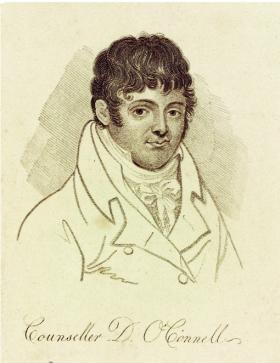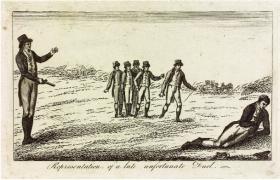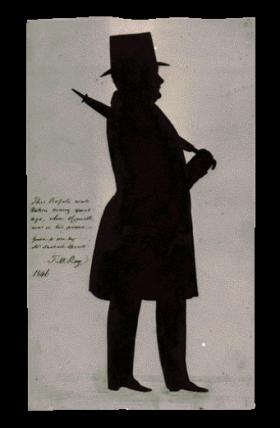‘When the blood was bubbling in my veins’
Published in 18th–19th - Century History, Features, Issue 1 (Jan/Feb 2009), Volume 17
‘Councellor O’Connell’, Dublin Magazine, March 1813. (National Library of Ireland)
At the time of the Ennis hustings O’Connell was 54 years old. This O’Connell was a devout Catholic, an implacable opponent of violence (and who hated in particular the vice of duelling), and a person of strong moral character. When we think of O’Connell we think of this older man, opposed to violence, religious, hard-working and supremely self-confident. It was this man who won Catholic emancipation in 1829 and who was later broken by the weight of expectations and his failure to repeal the Act of Union. The danger is to read this back into his earlier life. The O’Connell of the 1790s was a very different kind of man: reckless, immature, untested and unsure. And like many young men in their twenties, O’Connell drank, chased women and got into trouble.
Duelling
It had been the same when O’Connell was in London, training to be a barrister. From his diary we have many accounts of drunken late-night revelries, often ending in disaster. One night in 1795 he got drunk with some friends at a tavern in Turnham Green. On the way home, one of his friends decided to bang on every door they passed, disturbing the peace and provoking a fight when one angry landlord decided to investigate. The landlord challenged the men to a fight and O’Connell promptly volunteered. A brief scuffle ensued, and in the end O’Connell and his friends were taken into custody. Later in the year, drink (and women) was at the heart of a clash with Douglas Thompson, the son of a brewer. Both men were rivals for the affection of a young woman, and Thompson reacted angrily to what he thought were O’Connell’s attempts to sabotage him. For some days after it looked like the quarrel would result in a duel. Deciding to resolve the matter, O’Connell set out for Thompson’s house. But Thompson was in no mood for conversation and grabbed a cane, hitting O’Connell three times. Despite being a considerably larger man, O’Connell did not strike back. Afterwards he asked a friend to send a challenge, but Thompson’s family intervened and arrested the man, and followed this by threatening legal proceedings against O’Connell.
So why hadn’t O’Connell struck back? It would be a mistake to see this as evidence of O’Connell’s later hatred of violence. The traditional image of O’Connell as horrified by violence because of his limited experiences of the French Revolution is misleading. After all, O’Connell killed a man in a duel in 1815, and immediately followed this by getting involved in a second. Afterwards he would renounce duelling and be filled with genuine remorse for his actions, but before that he had ambivalent views on violence. In the 1790s he was strangely fascinated by duelling, writing in his diary that it had a ‘certain charm’, even though he knew it was a vice. He believed that it gave a man ‘independence’, and that this endeared it ‘even to many thinking minds’. These reflections were written in the middle of the dispute with Thompson. O’Connell was haunted by his failure to strike back, fearing that it showed a failure of nerve. He attempted to rationalise his actions, claiming that because he was the bigger and stronger man he might have killed Thompson if he had struck back with his cane. But he was unable to convince his friends, or himself. For years afterwards O’Connell worried about his response, and about whether he had the courage to test himself on the field of battle. In 1813 he challenged an opposing lawyer, Maurice Magrath, to a duel after Magrath had surreptitiously kicked him under a table during a trial. O’Connell had responded immediately by striking him in the face with his brief, but was still not satisfied and afterwards issued a challenge. But at the appointed place a compromise was arranged and O’Connell backed down. Immediately stories circulated that O’Connell had flinched and had been afraid to fire. His courage was doubted, and even some family members warned him of the shadow this cast over his character.
The fatal duel with D’Esterre in 1815 had its origins in this affair. D’Esterre was certain that O’Connell was a coward and would refuse to fight if challenged. And he gambled that even if O’Connell accepted it would make no difference, as D’Esterre was a former royal marine and a crack shot who, it was said, could snuff out a candle at nine paces. Recognising that he would never be safe unless he faced D’Esterre down, O’Connell accepted the challenge and met D’Esterre at Bishop’s Court, Co. Kildare. D’Esterre made a double miscalculation. He shot early and too low and missed. But he had also underestimated O’Connell, himself a crack shot and someone who had trained for years for this very eventuality. O’Connell took careful aim and shot D’Esterre dead. He later boasted that he could have hit D’Esterre wherever he wanted. That said, he had not wanted to kill D’Esterre, only to wound him, and was shaken when the bullet lodged in D’Esterre’s spine and proved fatal.

The D’Esterre duel—John Norcot D’Esterre was a member of Dublin Corporation who took offence in 1815 at O’Connell’s description of the body as ‘a beggarly corporation’. It is possible that he took the comment personally, for he was heavily in debt, but it is more likely that he saw challenging O’Connell as the means to his own political advancement. He attempted to horsewhip O’Connell in public, marching down to the Four Courts but leaving quickly enough to avoid actually seeing him. He was caught off guard, however, when O’Connell accepted the challenge and named the time and place for the very next day. O’Connell killed D’Esterre in the duel but afterwards offered a provision to D’Esterre’s widow and assisted her daughter in a number of legal matters. (Irish Magazine, March 1815)
‘One of the most abominable and bloodthirsty republicans’
The French Revolution is too often credited with shaping O’Connell’s later views on politics and violence, and O’Connell was happy to encourage this interpretation in the 1840s. Certainly it was the case that when O’Connell fled from France in 1793, immediately after the execution of King Louis XVI, he was, in his own words, a violent anti-revolutionist and ‘a Tory’. But the political repression he observed in London in the 1790s shifted his beliefs again. He became a radical, an admirer of the works of William Godwin and an opponent of the counter-revolutionary actions taken by William Pitt’s government. When he returned to Ireland he joined the United Irishmen and attended debates on the state of Ireland. O’Connell was outspoken in his political beliefs, and friends warned him to hide his true feelings or risk being arrested. In March 1798 O’Connell had dinner at the home of Bernard Murray, a respectable cheesemonger. The state of the country was discussed during the meal and O’Connell launched into a strong attack on the government. According to one account, O’Connell was so carried away that he called for a prayer-book so that he could swear in some enthusiastic young guests as United Irishmen, which, if true, was a capital offence.
On the way home from this dinner, O’Connell came across a man being beaten up by a gang of thugs. His blood up, he rushed to the defence of the man, knocking down three of the attackers. But, outnumbered, he was grabbed from behind and ‘beaten savagely in the face’. The attackers then ran off. Because of his injuries, he was forced to keep to his bed for a number of days, and his landlord took the opportunity to lecture him against committing himself politically.
In the lead-up to the 1798 Rebellion, O’Connell was included in a report given to Dublin Castle on radicals in the city. The source was Francis Higgins, a key informer, and he reported on a meeting that had taken place in a private room in the Eustace Street library, which was sometimes used by the United Irishmen. Higgins got a number of personal details wrong, but he was probably accurate enough when he reported that O’Connell was ‘one of the most abominable and bloodthirsty republicans I ever heard. He is open and avowed in the most daring language’. In the same period O’Connell tore out pages from his diary, fearing that he would be arrested and that the content would incriminate him. Following the outbreak of the 1798 Rebellion, O’Connell boarded a potato-boat and went home to Kerry, almost certainly because he feared being taken up.
Even in this radical period O’Connell had his doubts about the effectiveness of physical force. He had great respect for the men (and women) who rose up in 1798, but was much more cynical about the leaders, the majority of whom he viewed as ‘trafficking speculators’. Watching the failure of the Rebellion convinced him that ‘physical force could never be made an available weapon to regenerate’ Ireland: instead, ‘the best, the only effective combination must be that of moral force’. In later years O’Connell admitted that he could never bring himself to speculate about whether an insurrection might actually succeed, because in that case he might very well be tempted to support it.

Painting of Derrynane House, O’Connell’s country seat in County Kerry, in the 1830s. (National Library of Ireland
Lazy and reckless with money
The O’Connell of the 1790s was a young man searching for an identity and a role in life. But he had two serious failings, one of which he was able to correct, the other of which was to torment him for the rest of his life. First, he was lazy; he liked to stay in bed late and was often unable to rouse himself for work. Training to be a lawyer in London in the 1790s, O’Connell lived a typical student’s lifestyle, going out every night and then staying in bed for anything up to eleven hours. In his diary he lamented his laziness, fearing that it would prevent him from making anything of his life. In this period he was filled with self-doubt, his insecurities in constant conflict with his overwhelming sense of his own destiny. But by 1810, when he was becoming one of the dominant figures at the bar, he had learned discipline. This O’Connell was a man of energy and determination, who divided his time between meetings of the Catholic Committee and the law courts, rising at 4am and working on his law cases in the morning before heading off to the Catholic meetings after finishing at the courts. But the second failing proved impossible to shake. O’Connell was reckless with money, always getting into debt and never knowing how to economise. In the 1810s and 1820s he was one of the leading barristers in the country, with impressive annual earnings, but he still managed to rack up debts that were over five times his annual income. With a wife and family depending on him it was incredibly foolish, but O’Connell did not know how to live any differently. His brother James believed that O’Connell had been struggling with debt since the age of fourteen.
Part of the problem was the financial obligations caused by his sexual misadventures. There is no doubt that as a young man O’Connell was a womaniser. When he fell in love with Mary O’Connell in 1800 he made a fairly full disclosure about his previous dalliances. He told her that he would not pretend that this was the first time he had spoken to a woman about love, though he did admit that this was the first time he had meant it. Years later, when they were happily married, she still teased him, not so gently, about ‘your female acquaintances before I knew you’. These entanglements also brought with them some financial obligations. In the 1790s he had a sexual relationship with a woman we know only as ‘Mrs Y’ and felt obliged to contribute to her support when it ended. The nature of this obligation is not clear. It does not necessarily mean a child, as in this period men sometimes paid women to compensate for ‘ruined prospects’. Mary was remarkably understanding about these complications. In 1812 she received a number of anonymous letters from a female correspondent in Bristol accusing Daniel of various kinds of sexual misconduct. Mary suspected that they were from one of her husband’s former lovers and was more worried about being dragged into another financial obligation that they could not afford.
Unsure about whether he was ‘a man or a cabbage-stump’
The one thing that really bothered Mary was her husband’s lack of religious faith. In the 1790s he became a deist, believing in some ‘eternal being’, remote and unmoved, and made a deliberate decision to substitute philosophy for religion. A young woman who stayed at the same boarding-house in London was so amused by O’Connell’s capacity to doubt that she predicted that in 50 years he would be unsure about whether he was ‘a man or a cabbage-stump, so much was he inclined to scepticism’. When he married, O’Connell’s lack of faith was a source of deep unease for Mary O’Connell. When there were difficulties with her first pregnancy, O’Connell lamented the fact that he was not ‘a religionist’, otherwise he would spend every moment praying for her, and he regretted ‘this miserable philosophy which I have taken up and been proud of—in the room of religion’, which gave him no consolation in his misery. After much gentle persuasion, in 1809 he returned to the church, but the return was either temporary or shallow, for he drifted away again soon after. It was only in 1816 that O’Connell underwent a lasting spiritual conversion and became a devout Catholic. Mary was delighted with the news, and O’Connell himself admitted that he felt ‘beyond any comparison happier in this change’, hoping that it would ‘prove complete’. O’Connell’s children were also aware that he had had a religious experience: Mary said that their son, Maurice, ‘thanked God with his hands clasped for your conversion’. For the rest of his life he would remain a devout Catholic, renouncing duelling and feeling genuine remorse about the killing of D’Esterre and the recklessness that had almost led to a second duel.

‘This profile was taken many years ago, when O’Connell was in his prime. Given to me by Mr Michael Spratt. J. M. Ray 1846.’ Note the military bearing, with the umbrella shouldered like a weapon, in contrast to what O’Connell perceived to be a subservient ‘Catholic’ gait with head down and shoulders hunched. (National Library of Ireland)
When O’Connell raised the subject of his wild youth (and the fact that he had been ‘inattentive to the function of my religion’) at the Ennis hustings in 1828 he was making a deliberate point. He wanted to show that despite all his youthful indiscretions he had never abandoned his religion and he had never denied it, even though doing so would have enabled him to achieve all his life’s ambitions (that of becoming a king’s counsel and a member of parliament). He wanted to show that he had remained true to the Catholic cause even when he had lost his faith, and that he had worked tirelessly for Catholic emancipation for a quarter of a century, even in the years when it would have been considerably easier to renounce it. As a young man, O’Connell had grasped that being a Catholic meant something more than just following a set of religious beliefs. He saw that in Ireland being a Catholic helped to define a person, that it gave a sense of identity and a sense of inferiority. He came to believe that you could tell a Catholic on the street by the way he walked, his head down, his shoulders hunched, weighed down by a culture of defeat that had kept Catholics subdued for centuries. He came to realise that what was needed was someone to challenge this culture of defeat, to fight the establishment on its own terms, to bully, to intimidate, to refuse to be cowed. Like many young men in their twenties, O’Connell was reckless, raw and searching desperately for his role in life. But it was in this very period that he came to realise what it meant to be an Irish Catholic, what was needed for Ireland and what role he would have to play. It was a realisation that would help to make him ‘the Liberator’. HI
Patrick M. Geoghegan lectures in history at Trinity College, Dublin, and is co-presenter of Newstalk radio’s Talking History.
Further reading:
P. M. Geoghegan, King Dan: the rise of Daniel O’Connell, 1775–1829 (Dublin, 2008).
O. MacDonagh, The hereditary bondsman: Daniel O’Connell, 1775–1829 (London, 1988).
W. J. O’Neill Daunt, Personal recollections of the late Daniel O’Connell MP (2 vols) (London, 1848).
















